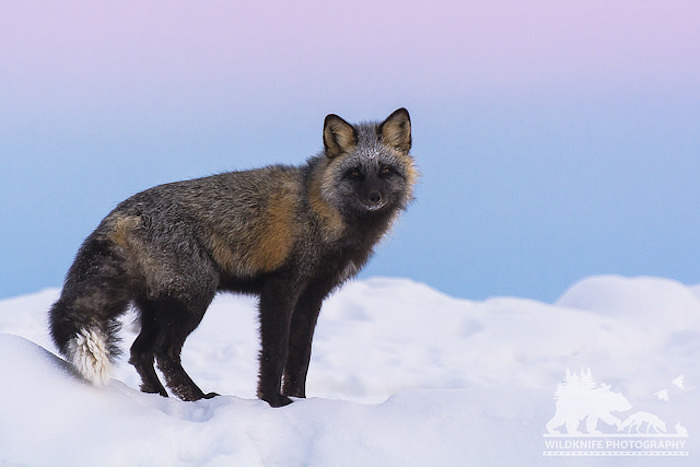Yellowknife can be a great place to visit in the winter. There are lots of things to do from aurora tours to ice fishing to snowmobile adventures. There are lots of opportunities to see wildlife in the winter and with the abundance of snow, you’ll also have a chance to practice your tracking skills.
Winter in Yellowknife is long, so expect to see snow and ice from October to May. Days are shorter so if you’re wanting to see wildlife during the day, know that your window of opportunity is much shorter than in summer months. Your best chances of seeing birds are at the beginning and end of winter when birds are migrating south or returning in the spring to breed.
Opportunities Inside the City
Frame Lake Trail
The Frame Lake trail loops around Frame Lake and offers a number of wildlife viewing opportunities. In the winter you can expect to see willow ptarmigan, magpies, ravens, red polls, house sparrows, red fox, and occasionally coyotes. Once in a rare while an arctic fox or wolf is spotted on or near the lake but these are extremely rare sightings.
Note that the area between Jackfish Lake and the Frame Lake Trail is known coyote territory so be sure to keep your dog leashed at all times to avoid a potential conflict.
Niven Lake Trail
It can seem pretty quiet around the Niven Lake area once the snow falls but you can still find ptarmigan, woodpeckers, house sparrows, red polls, white-winged crossbills, snow buntings, magpies, ravens, and foxes. Once in a while, there are reports of a lynx or wolverine but these animals are a very rare sight.
Rotary Park
Rotary Park is home to ravens, magpies, and ptarmigan as well as the occasional fox and coyote. There is a boardwalk that will take you out to a viewing platform in the wetland area, though the gulls and waterfowl won’t start appearing until late April or May.
Ski Hill and Back Bay
This narrow valley is a favourite spot for many winter activities including wildlife viewing. There are plenty of species to watch for including owls, squirrels, hares, ptarmigan, fox, raven, and magpies. In the spring and fall, there are plenty of birds that make their home in this densely forested area while they raise their young.
The ski hill and back bay are well known for coyote dens so there is a chance you may encounter one or more. Coyotes prey on small rodents, ptarmigan, and snowshoe hares all of which can be seen in this area.
Occasionally timber wolves will pass through this area so watch the trails for wolf tracks and be aware of your surroundings. Wolves are masters at disappearing into the forest but pay attention and you might catch a glimpse of one of the North’s most magnificent creatures.
If you plan to hike or sled in this area, be sure to keep your eyes open and your dog leashed to avoid conflicts with wildlife.
Rat Lake and Tin Can Hill
Rat Lake and Tin Can Hill run parallel to Great Slave Lake and are a favourite destination for dog walkers. This doesn’t make for great wildlife viewing, however, there are still a number of animals you might spot if you get there before the dogs. Coyotes, foxes, ptarmigan, ravens, woodpeckers, owls, boreal chickadees, grey jays, and other winter birds can be spotted in this area. In the spring and fall, this is a popular area for birdwatchers.
Wildlife Outside the ‘Knife
Ingraham Trail
The Ingraham Trail offers wildlife enthusiasts a number of opportunities to view wildlife in its natural habitat. From river otters, to timber wolves, to lynx you never know what you might see on a trip up the trail.
There are hundreds of lakes spread across the NWT and a trip up the trail will quickly give you an idea of the vast amount of water available for wildlife.
Foxes are a common sight both within and outside the city. Inside city limits, foxes are protected from hunters and trappers so they are more tolerant of people. This does not mean you should feed them or try to pet them. This is against the law. Outside the city, expect foxes to be much more skittish than their city-dwelling cousins.
The Prelude Lake Nature Trail is a wonderful place to spend a morning or afternoon wildlife spotting. It offers a number of opportunities to see birds and wildlife as it meanders through a number of different types of northern landscape. Small mammals such as snowshoe hare, porcupine, squirrels, and grouse might be spotted along the trail.
Cameron Falls Territorial Park is another great place to stop if you are interested in wildlife. It is well outside city limits so make sure you are prepared before you leave. The Cameron River is home to a family of river otters who show up once in while to frolic and fish in the pools at the base of the ramparts. Otters can be spotted summer or winter.
Other animals you’ll want to watch for in this area include great horned owls, grey jays, pine marten, lynx, and wolves. Be sure to take some peanuts for the grey jays who will take them right out of your hand if you’re patient.
Highway 3
Just past the city limits along Highway 3, there are a few spots that offer fantastic wildlife viewing. Owls, bison, wolves, and moose can be spotted along this stretch of highway between October and April. You might also catch a glimpse of a lynx, caribou, or wolverine but travel can be treacherous so be prepared and check the weather.
Wood Bison Sanctuary
If you’re wanting to see North America’s largest land mammal, the wood bison sanctuary near Fort Providence almost guarantees a wood bison sighting. Many times you can spot these frosty behemoths around North Arm Park about an hour west of Yellowknife. There is nothing quite like the sight of a bull bison covered in snow. Bison are almost invisible in the dark so be extra cautious when travelling in this area between September and April.
This article was written by the local photographer, Marcus Jackson, who has been photographing the wildlife around Yellowknife for a number of years. You can view more of his wildlife photography on his website WildKnifePhotography.ca or by following his work on Facebook @WildKnifePhoto or Instagram @wildknifephoto.
Marcus also produced a pocket-sized photography guide to help budding photographers or old pros get creative with their photography regardless of location, subject matter or gear. It would be a great addition to any wildlife photography adventure around Yellowknife. You can check out The Photographers Creative Playbook here.









